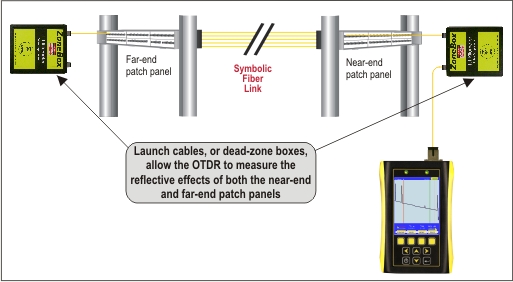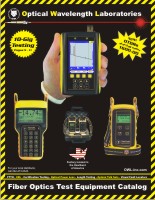| DEAD ZONE BOXES |
| Reflections caused by connector interfaces “blind” OTDRs for a short period of time. The period of time it takes for an OTDR to recover from this “blindness” is commonly referred to as a “dead-zone”. During this dead-zone period, OTDRs are unable to distinguish one anomaly (e.g. breaks, shatters, bends, or even another connector) from another.
OTDR launch cables, or dead-zone boxes, placed at near-end patch panels allow the OTDRs detector port sufficient time to recover from its blindness. Dead zone boxes also enable the OTDR to measure the relative loss through the near-end and far-end patch panels (see diagram below). Without a sufficiently long launch cable, the reflection from the near-end patch panel will be undetectable because it is within the dead-zone caused by the OTDR port. Likewise, at the far-end, lack of a dead-zone box will prevent the OTDR from measuring the relative loss through the far-end patch panel. In most cases, launch cables that are slightly longer than one kilometer are sufficient to account for dead-zones on nearly all fiber links. However, longer launch cables may be needed for long-haul fiber optic links. |
 |
| VIDEOS | ||
| Number | Description | |
 |
C1007 | Explains the concept of OTDR dead zones, the effect of dead zones on OTDR measurements, and the use of dead zone boxes to counter the effects of dead zones. |
 |
M1004 | Introducing the OWL pulse suppressor box |
| Pricing | ||||
| Part # | Length | Fiber Type | Connector Type | Price |
| DZB-SM-1100 | 1100 meters | Singlemode | SC/UPC | 415.00 |
| DZB-M6-450 | 450 meters | 62.5/125um multimode | SC/UPC | 370.00 |
| DZB-M5-450 | 450 meters | 50/125um multimode | SC/UPC | 370.00 |
| Need a dead-zone box with custom specifications? Give us a call at 262-473-0643 | ||||


